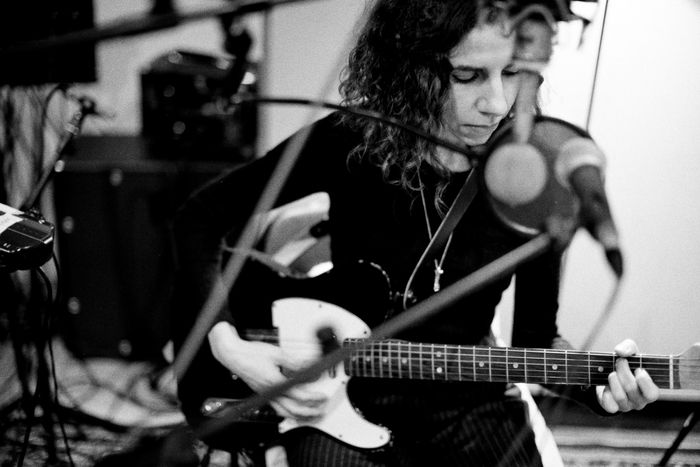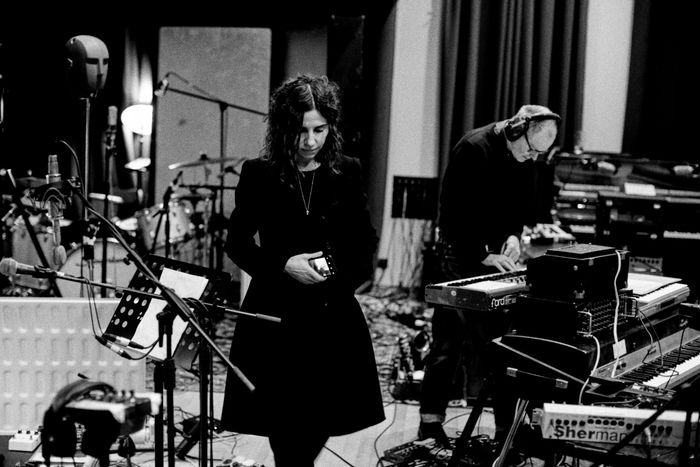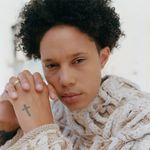
PJ Harvey has achieved one of music’s rarest feats: a water-tight discography with few weak spots and little repetition. The lone throughline in her work is a desire to convey multiple states at once, collapsing the boundaries between dreaming and waking, euphoria and melancholy, life and death. For three decades, that approach has received unwavering adulation from fans, critics, and peers. Kurt Cobain listed Dry as one of his all-time favorite albums; three of her LPs (Rid of Me, To Bring You My Love, Stories From the City, Stories From the Sea) appear on Rolling Stone’s list of 500 Greatest Albums of All Time; and she is the only artist to have won the U.K.’s prestigious Mercury Prize more than once.
Now in her early 50s, Harvey is bringing life to imagined worlds that resemble modern folklore, inhabited by characters rich with contradictions and duality — no more so than on her latest album I Inside the Old Year Dying, one of her strangest and most ambitious achievements yet. The project is a musical extension of 2022’s Orlam, an epic coming-of-age poem that Harvey composed over the span of eight years. Written largely in Dorset dialect, it chronicles a year in the life of its 9-year-old protagonist Ira-Abel, a West Country girl who encounters perverse horrors, spectral magic, and horny goats and gods in the English countryside.
While Harvey originally intended to turn her poem into a piece for the theater, the words took on a new life when she applied them to piano and guitar. That rush followed a period of musical silence from Harvey. The exhaustion caused by her last tour in 2017 had prompted an existential reckoning, and she wondered whether she’d lost her touch or if her love for music had dwindled. Now, as she prepares for her first tour in six years — with stateside shows due for fall 2024 — Harvey seems to have refound her purpose: “I feel excited and ready and confident that the show is a strong one.”
You originally envisioned Orlam as a piece for the stage. Are you bringing any of those ideas to the I Inside the Old Year Dying tour?
This show with my band isn’t really connected to Orlam. I think that I Inside is a strong piece of work that stands on its own. I don’t think that that piece needs Orlam to be understood and so we’re really presenting the album as well as my back catalog of songs. It’ll be a look at all of my material over the years but with a concentration on the latest album.
How far back does the catalog stretch on the setlist?
Oh, back to album one. I think it’ll be a really comprehensive show for all ages of PJ Harvey fans. It’s been a great joy actually to play some of those earlier songs. I haven’t played many of them live for years. So I think it’s gonna be a special show for that reason as well.
How has it been embodying the voices of early PJ? Were you able to jump right back in?
Not all the time, so I had to choose the songs quite carefully. I worked very closely with John Parish, who’s been my right-hand man for 30 years. John and I chose what we felt worked well with I Inside in terms of lyrical content and musicality so that the evening has a certain feel to it and doesn’t lean into lots of radically different fields. But I think over the evening, it will be a very slow progression. A sort of gradual change occurs rather than lots of greater changes all the way through.
Have you thought at all about what your relationship with the audience will be like on tour? Do you have any expectations for a post-pandemic audience?
It hadn’t even occurred to me to think of it in a different way. But you’re right in flagging it because I do think it’s taking us quite a long time to adjust to going out into crowds again. I say that because even myself, going out to crowded theater shows or concerts recently, I sense that people are still a little bit cautious.
The only way I might be performing a little differently is purely through getting older — 2017 was my last tour and now I’m at that age where your body changes, and it has different needs, and it can cope with different things in greater or lesser degrees. So I’m looking after myself now as a 53-year-old and that will change the show. But there are wonderful things too, in that my voice is actually better than it’s ever been. I think that is one of the lovely things about getting older as a singer, your voice discovers new depths and greater soulfulness because as we get to know ourselves better, we get more comfortable and accepting of ourselves. The voice is an instrument that you carry with you inside and it’s affected by emotion.
That’s a phrase you’ve used a lot in your latest press cycle: “As I get older.” I’m curious to know whether there was a certain event or marker in time that made you realize, Okay, this is it; I’m in the “older” part of my life now.
It’s funny, I suppose turning 50 is quite a big one. I remember the other one was turning 30. That felt like a milestone to me. I’m not sure when my next one will be — 65, maybe. But I also remember thinking on the last tour: Gosh, it’s taking me longer to recover after a show than it used to. So I noticed it then in quite a big way. When I was a younger woman, I could spring back easily because a show takes a lot out of you. It’s an hour and a half of movement and singing, and singing requires a lot of energy and a lot of use of the diaphragm muscle and all the stomach muscles. So you have to be really fit. And then you put movement and dancing on top of that. I mean, I’m so glad I’m not a dancer or a tennis player because their lifespan can be, you know, a lot less than a singing performer.
Do you see any parallels between childhood and getting older? It seems you’ve refound the kind of joy and creative capacity one might have had as a child.
Ah, I think so, especially going into Orlam and the writing of it. Obviously, I had to draw a lot on childhood memory, but I also spent a lot of time reading other books that do similar things. And I think it did take me back to my childhood feelings and imagination. But also, as a creative artist, you never stray too far from that, because the life you have to go into in order to create has to be quite childlike and playful.
It’s such a joy to read Orlam aloud. I feel like I’m put into that childlike state when I read the Dorset dialect; I instinctively understand the words, despite not quite having a context for them. I’d love to hear you talk about your role in the preservation of the dialect.
I don’t want to sound too highfalutin, but I did feel it was important to carry on the tradition and not let this dialect die out. I love language and I love dialects from all countries and from all counties. I think it’s absolutely fascinating how words have evolved and changed over so many years. So to even have a small part in trying to keep this alive is really important to me, and I’ve been so happy to see how many people have enjoyed Orlam and have become interested in that part of the world.
Do you remember the first poem you ever wrote?
I do. I think it was about my friend Cindy. I had obviously fallen out with her. It was a poem about “I hate Cindy because she is mean;” it was something about shoes as well. I’d also write poems about our animals, our cats, and our sheep. It was when I first learned to write. We used to have these little books at our first school when I was 5 or 6. They had lines at the bottom and a blank space at the top, so you could do a little drawing and you could write a few words. And I loved this book. I carried it around with me while playing in the garden or in the woods. Wherever I was I was making little drawings and writing little poems. I’ve still got it because my dear mum saved everything myself and my brother ever did. I treasure it.
Would you ever want the public to see these early poems?
Well, I’m putting together an art exhibition, which we hope to present sometime next year or the year after, but it’s pretty much going to show everything I’ve ever drawn. And I actually find that quite lovely.
Back to the tour. Do you have an outfit planned?
Yes, I’ve been working with a designer that I’ve worked with for many years. His name is Todd Lynn. And I first started working with him in 2001. I think the first outfit he made for me was the leather suit that I wore in the “This Is Love” video. It’s like a beautiful sort of tailored leather Elvis jacket with fringes. He and I became friends after that. This is the first tour that we’ve done together. We’ve come up with an evolution from the dress that you see on the back of the I Inside album cover. So there are different themes on that dress for this tour.
I believe I might have spotted a safety pin on that dress, which made me think about how keen you’ve been in recent years to show the early drafts of your work, whether that’s been recording an album in front of a live audience or releasing your demos. Why do you feel it important to expose the creative process as well as the final product to your audience?
It’s not even something I contrive to do; it just happens. You know, I think that I feel more comfortable now than I used to as a younger artist, but I like showing the process because there’s often quite a journey to get from one place to another. I mean, you see it in the poetry drafts. It’s a lot of work and a lot of time. I also think it can be useful to younger artists to see that process.
Going back to the costumes, Todd and I decided that we almost wanted to present what would be the first draft of the costume. So for instance, the back of the album dress is like the first draft. It’s a tulle. It’s made in very cheap material, and we’ve continued that theme into the actual dress that I’m wearing on stage. I think there is something beautiful about showing this sort of skeletal process behind it all.
I’m curious to know what will be on your mind as you try to recreate the voices and embody the characters of I Inside. Will you be thinking about the conditions that were created for you in the studio, for instance?
No, I always think of the story I’m telling. I worked for years with a wonderful theater director called Ian Rickson. I worked on soundtracks for his theater plays and then we became greater friends and developed a deeper, collaborative relationship. From Let England Shake onwards, he’s directed my live shows. Something I’ve learned from observing him directing, not only actors but also myself, is that if you visualize something in your head while singing it, the audience will see it.
Do you see “PJ Harvey” as a separate character, someone distinct from yourself?
No, everything feels very me. I don’t feel like I have to embody a different person. But like an actor, I can inhabit different characters to portray the vehicle of the song like an actor would portray a character in a film. So it doesn’t mean I’m not Polly doing that.
It was on your last tour that you had this big reckoning of “Do I even want to do this anymore?” Now that you’ve been through that, do you feel more purposeful going into this one?
I do. I think I had to go through that questioning. I had to ask myself: Is this still the thing that feels best to put my energies into, and is it the best contribution I have to give? And I think the answer is yes. I think that’s been shown to me during rehearsals and during the making of the new album, where I felt sort of in the place I should be and doing the thing I can do best in this world.





